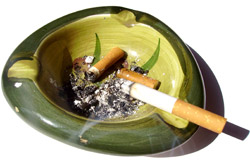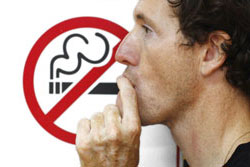- Introduction to smoking
- The impact of tobacco smoking in Australia
- Why quit smoking?
- Physiological benefits of quitting smoking
- Quitting before pregnancy
- Health benefits for family and friends
- Reducing cigarette use
- Financial benefits of quitting
- Psychological benefits of quitting smoking
Introduction to smoking

This trend is continuing into the 21st century, with the World Health Organisation estimating that about 5 million people around the world die from smoking every year. With the extensive knowledge we possess regarding the detrimental health effects associated with this habit, it is time to quit.
The impact of tobacco smoking in Australia
Health impact
In 2003, tobacco smoking was the second leading cause of disease burden in Australia, (obesity being the leading cause), with 15,511 smoking-related deaths. The Australian Bureau of Statistics estimates that 8% of the total disease and injury burden in Australia is attributed to tobacco smoking. 20% of all cancer deaths are due to smoking – more specifically, 80% of lung cancer deaths in 2003 were attributed to tobacco smoking.
The most recent smoking statistics have confirmed that daily smoking rates are declining. In 2007, 16.6% of Australians over 14 years smoked daily, which is almost 3% less than the 19.5% of smokers in 2001. The rate was slightly higher for men at 18%, and was 15.2% for women. The highest rates of smokers were found in the 18–24 age bracket for males, and the 25–34 age bracket in females. In the 12–17 age bracket, 9% of boys and 10% of girls admitted to smoking in a survey conducted in 2005; these figures peaked at age 17.
Indigenous Australians have the highest smoking rates, with 50% of adults smoking daily in 2005. Manual labourers and factory workers have a higher incidence of smokers (almost 40%) than office workers and professionals (approximately 13%).
Economic impact
In 2004–2005, the cost of smoking to Australia was $31.5 billion dollars. This figure is thought to be quite conservative, as it does not include hidden social costs such as reduced workplace productivity, litter, extended hospital stays (due to decreased post-operative outcomes), medical costs associated with birth complications, and mental and emotional suffering experienced by smokers and their family and friends.
Treatment of disease is one of the major costs attributed to tobacco use. Lifetime costs for smokers are greater than for non-smokers, even when taking into consideration that non-smokers live substantially longer than smokers. Treatment of disease includes medical costs, hospital, nursing home, pharmaceutical and ambulance. It is not just the individual and the government that bear these costs, but businesses, employers and society as a whole.
The costs borne by businesses include increased rates of absenteeism and loss of labour, which are substantially more in smokers than in non-smokers.
Governments provide mass education and health campaigns in order to deliver information about the dangers of smoking, which add substantially to the overall cost that Australia bears.
Why quit smoking?

The earlier you quit, the greater the benefit of quitting. Smokers who quit when they are 30 years old can avoid most of the excess risk and add about 10 years to their life expectancy. Quitting at 50 can halve the risk of dying from smoking and add 6 years to life expectancy. Even stopping at 60 can have benefits, raising life expectancy by 3 years.
Some health benefits of quitting can be noticed as soon as smoking stops. Within only a few hours without a cigarette, the carbon monoxide levels in the body are decreased, followed a week later by a decline in nicotine levels. After 5 days without a cigarette, you may notice an improvement in taste and smell.
For some people, the health benefits of quitting continue for years after they quit. In some cases, former smokers may even return to being as healthy as a non-smoker and carry the same risk of disease, although this does not apply to cancer. People who have smoked will always have a greater risk of some cancers than people who have never smoked.
 |
Have you quit smoking? Or are thinking about trying to quit? Use this tool to see what health benefits you have already achieved and what benefits you can expect in the future if you stick with it. For more information, see Health Benefits of Quitting Smoking Tool. |
Physiological benefits of quitting smoking
After quitting smoking there are a multitude of benefits for your body, some noticeable and some not. Some effects will occur straight away and others may take a number of years. As the amount of time since your last cigarette increases, you will be fitter, have less risk of developing disease, and feel healthier.

Everyone’s lungs stop working as well the older they get, but for smokers this process happens sooner, faster and more severely. Smoking also causes permanent damage to lung tissue. By quitting smoking, you will give your body the best chance of improving airway functioning and stopping any further damage.
The benefits to the lungs are widespread:
- 1 month after quitting smoking, improvements in airway function are noticeable;
- After 2 months tobacco-free, your cilia resume their proper functioning. Cilia are little cells that line the lungs, and their job is to clear the lungs of mucus and debris. Once the cilia start performing their normal duties, the rates of chronic coughing, bronchitis, respiratory infections and pneumonia will also decrease;
- Quitting slows the increased pulmonary function decline experienced by smokers;
- Hospitalisation and symptoms of chronic obstructive pulmonary disease (COPD) are reduced;
- Post-operative pulmonary complications associated with smoking are reduced;
- Lung cancer is substantially reduced in those who quit smoking by 30. At 50, the risk for lung cancer is reduced by half, compared with someone who continues smoking for another 25 years; and
- The positive effects on the lungs will allow an increase in exercise capacity and therefore fitness will improve.
The positive effect on the lungs will really start kicking in around 2 months after quitting, as long as there is no permanent emphysematous lung damage.
Blood
After not smoking for 24 hours, the levels of carbon monoxide in the body system reduce dramatically, which frees up haemoglobin. Haemoglobin is responsible for transporting oxygen; therefore, if more of it is available, then more oxygen will be transported around the body.
Greater oxygen levels and better oxygen transportation throughout the body have many health benefits:
- After 6 weeks, wound infection is less likely; and
- After 6 weeks, blood viscosity is improved, which has a positive effect on blood flow to the hands and feet. This reduces the risk of peripheral vascular disease. For those who already have the disease, amputations are less likely to be necessary.
Heart
Smoking promotes thickening of the arteries, or atherosclerosis. Atherosclerosis is associated with many negative health outcomes in various body systems, including the heart.
By quitting smoking, atherosclerosis is less likely to occur and therefore the risk of developing heart disease is reduced. After 1 year without smoking, the risk of developing heart disease is half as much as it would otherwise be. Amazingly, after 15 years without smoking, your risk of developing heart disease is equal to that of someone who never smoked, which means you have a chance to reverse the negative effects of smoking on the heart.
Blood pressure returns to normal levels 2 months after smoking cessation.
Brain
Atherosclerosis increases the risk of stroke, which is why smokers have a much higher risk of experiencing a stroke than non-smokers. Therefore, by not smoking for 2–5 years, you will reduce your stroke risk. Amazingly, after 25 years without smoking, your stroke risk is equal to that of a non-smoker.
Cancer
After 5 years without smoking, your risk of developing throat, mouth and oesophageal cancers is half as much as it would have been had you continued to smoke.
The risk of cancer in general for smokers will always be greater than that for non-smokers, even 15 years after quitting. This is not to say that there is no point in quitting. Every cigarette you smoke is exposing you to more carcinogens, and therefore the longer you smoke, the higher your risk of developing cancer. The sooner you stop, the lower your overall risk will be.
Eyes
Rates of blindness are reduced after quitting. After 20 years without smoking, you will have the same risk of age-related macular degeneration (the deterioration of vision with age) as a non-smoker.
 |
For more information, see How Smoking Affects the Eyes. |
Mouth
Smoking has a detrimental impact on oral health, including a reduced ability to smell and taste. Five days without a cigarette, smokers will notice an improvement in taste and smell.
Smoking tobacco is one of the principle causes of teeth discolouration. Quitting will prevent further staining.
 |
For more information, see How Smoking Affects the Mouth. |
Cosmetic
In addition to all the negative health impacts of smoking on the body, it also has a negative effect on your appearance. Smoking has been shown to have visible effects on the skin, including:
- Increased facial wrinkling;
- Premature ageing; and
- Decreased capillary and arteriolar blood flow.
These are effects you can actually see develop. Quitting smoking is the first step you should take in order to keep your appearance radiant and fresh-looking.
 |
For more information, see How Smoking Affects Skin Health. |
Immune system
Within days of stopping smoking, previous smokers will experience improvements in immunity. This means fewer colds and flu, fewer sore throats and fewer infections!
Reproductive system
Tobacco can have detrimental effects on sperm production, including reduced concentrations of sperm in the semen and reduced concentrations of normal and motile sperm. In order to give yourself the best chance of conceiving, you should stop smoking.
 |
For more information, see How Tobacco Affects Sperm. |
Quitting smoking can also reduce erectile dysfunction caused by smoking.
Females who smoke are twice as likely to be infertile as non-smokers. This effect is reduced after stopping smoking, so quitting should be the first step taken by couples planning to get pregnant.
Quitting before pregnancy
In order to provide yourself with the best opportunity you can for a good pregnancy outcome you must quit smoking. It is best to quit smoking well before you become pregnant – this will:
- Reduce your chance of miscarriage, premature labour and placental abruption, all of which are associated with smoking during pregnancy;
- Mean you have no extra risk of having a low birthweight baby compared to a non-smoker. Lower birthweight babies have more chance of catching illness, developing disease and dying throughout childhood and adulthood.
While it is best to quit smoking before you conceive, it is still possible to reduce the risk of negative pregnancy outcomes by quitting up to two months after you become pregnant. This is not to say you should wait two months into the pregnancy before you try to quit. Cutting down on the amount you smoke without completely quitting will not be of any benefit to you or your baby.
In order to have the best possible pregnancy outcome, you must quit completely.
 |
For more information, see Smoking and Passive Smoking During Pregnancy. |
Health benefits for family and friends

Second-hand smoke is the smoke from your cigarette that has the potential to be inhaled by the people around you. Inhaling second-hand smoke, known as passive smoking, is associated with serious health consequences. The risks associated with second-hand smoking increase depending on the length of exposure to the smoke and how often the second-hand smoke is inhaled. For example, if you smoke a lot of cigarettes inside the house, the risk of negative effects on the health of people who live with you will be high.
People exposed to second-hand smoke have a greater risk of developing:
- Lung cancer;
- Coronary heart disease;
- Stroke;
- Cancers of the nasal sinus, pharynx, breast, cervix and bladder;
- Deficits in blood functioning, such as vasodilation (expansion of blood vessels) and vasoconstriction (constriction of blood vessels);
- Oxidative stress;
- Infections;
- Inflammation; and
- Reduced heart strength.
Research has determined that inhaling second-hand smoke is almost as dangerous as smoking. Within minutes of exposure to second-hand smoke, blood platelets are activated. After time, this can promote thrombosis, cellular artery damage and atherosclerosis.
Effect on infants and children
Children are especially susceptible to the negative health effects associated with second-hand smoke, both physically and environmentally. Children have immature lungs, a greater lung surface and a higher breathing rate than adults, which makes them more vulnerable to the effects of smoking than adults. Children cannot control their environment, so are often put in situations that render them unable to avoid second-hand smoke.
Children and infants exposed to environmental tobacco smoke have an increased risk of developing:
- Chronic respiratory symptoms, including asthma, decreased lung function and lower respiratory tract infections;
- Long term developmental effects;
- Childhood cancers;
- Reduced sense of smell;
- Middle ear infections; and
- Complications during surgery.
Reducing cigarette use

While you may think you are smoking less, it is believed that once you have developed a nicotine addiction, your brain requires a certain level to feel satisfied. This means that you are more likely to take more puffs and inhale harder if you reduce the number of cigarettes per day. You may not even notice you are doing this. In any case, you will not be reducing your exposure in the long run. In order to experience any benefit from quitting smoking, you must quit completely.
Financial benefits of quitting
Cigarette smoking affects more than just your health and the health of those around you. The financial impact can be huge; in 2008, pack-a-day smokers spent ~$3,000 per year on cigarettes! That can be a holiday or a new plasma TV! More recently, the Australian government has increased the excise tax on cigarettes by 25%. It is predicted that this tax increase will generate an extra $5 billion over the next 4 years, which will increase the annual cost for an individual smoker even more.
Life insurance and health insurance for smokers also tends to be more expensive. Furthermore, people who do not smoke tend to take fewer sick days, which will financially benefit casual workers.
[calc_smok]
Psychological benefits of quitting smoking
Quitting smoking will substantially improve your quality of life. Just think about how the following will improve your day-to-day life:
- Not having to constantly and intermittently leave social occasions to have a cigarette;
- Not having bad breath, smelly hair and smelly clothes;
- Being able to play chasey with your kids for longer; and
- Not having the extra financial burden of the expensive habit!
Quitting is a truly positive step to take. If you accept the challenge to quit and succeed, you will experience a boost in confidence which will carry over to all areas of your life.
Talk to your doctor about quitting today, and start your new, healthier life as a non-smoker!
More information
 |
For more information on smoking and its health effects, and some useful tools, videos and animations, see Smoking. |
References
- Worldwide smoking statistics [online]. Sans Souci, NSW: Think Quit; 2008 [cited 28 July 2010]. Available from: URL link
- Tobacco smoking in Australia: A snapshot, 2004-05 [online]. Belconnen, ACT: Australian Bureau of Statistics; 9 November 2009 [cited 10 August 2010]. Available from: URL link
- Smoking in Australia: Statistics [online]. Woolloomooloo, NSW: Cancer Council NSW; [cited 15 June 2010]. Available from: URL link
- Tobacco [online]. Canberra, ACT: Australian Government Department of Health and Ageing; 11 March 2010 [cited 28 July 2010]. Available from: URL link
- Lal A, Scollo M. The economics of tobacco control: 17.3 The costs of smoking to Australian society. In: Scollo M, Winstanley M (eds). Tobacco in Australia: Facts and Issues (3rd edition) [online]. Carlton, VIC: Cancer Council Victoria; 2008 [cited 15 June 2010]. Available from: URL link
- Lal A, Scollo M. The economics of tobacco control: 17.1 The economic rationale for intervention in the tobacco market. In: Scollo M, Winstanley M (eds). Tobacco in Australia: Facts and Issues (3rd edition) [online]. Carlton, VIC: Cancer Council Victoria; 2008 [cited 15 June 2010]. Available from: URL link
- Winstanley M. The health effects of active smoking: 3.6: Reproductive health and smoking. In: Scollo M, Winstanley M (eds). Tobacco in Australia: Facts and Issues (3rd edition) [online]. Carlton, VIC: Cancer Council Victoria; 2008 [cited 15 June 2010]. Available from: URL link
- Ellerman A, Ford C, Stillman S. Smoking cessation: 7.2: Health and other benefits of quitting. In: Scollo M, Winstanley M (eds). Tobacco in Australia: Facts and Issues (3rd edition) [online]. Carlton, VIC: Cancer Council Victoria; 2008 [cited 15 June 2010]. Available from: URL link
- Benefits of quitting [online]. Fairbairn, ACT: quitnow, Australian Government Department of Health and Ageing; 2007 [cited 28 July 2010]. Available from: URL link
- Yee BE, Ahmed MI, Brugge D, et al. Second-hand smoking and carboxyhemoglobin levels in children: A prospective observational study. Paediatr Anaesth. 2010;20(1):82-9. [Abstract | Full Text]
- Benefits of quitting [online]. Carlton South, VIC: Quit Victoria; 2010 [cited August 2010]. Available from: URL link
- Fertility: Assessment and treatment for people with fertility problems [online]. London: Royal College of Obstetricians and Gynaecologists; 2 January 2004 [cited 30 August 2010]. Available from: URL link
- Sham AS, Cheung LK, Jin LJ, Corbet EF. The effects of tobacco use on oral health. Hong Kong Med J. 2003;9(4):271-7. [Abstract | Full Text]
- Winstanley M. The health effects of secondhand smoke: 4.2: What is in secondhand smoke? In: Scollo M, Winstanley M (eds). Tobacco in Australia: Facts and Issues (3rd edition) [online]. Carlton, VIC: Cancer Council Victoria; 2008 [cited 15 June 2010]. Available from: URL link
- Winstanley M. The health effects of secondhand smoke: 4.3: What is in secondhand smoke? In: Scollo M, Winstanley M (eds). Tobacco in Australia: Facts and Issues (3rd edition) [online]. Carlton, VIC: Cancer Council Victoria; 2008 [cited 15 June 2010]. Available from: URL link
- Winstanley M. The health effects of secondhand smoke: 4.5: Lung cancer and secondhand smoke. In: Scollo M, Winstanley M (eds). Tobacco in Australia: Facts and Issues (3rd edition) [online]. Carlton, VIC: Cancer Council Victoria; 2008 [cited 15 June 2010]. Available from: URL link
- Winstanley M. The health effects of secondhand smoke: 4.4: Cardiovascular disease and secondhand smoke. In: Scollo M, Winstanley M (eds). Tobacco in Australia: Facts and Issues (3rd edition) [online]. Carlton, VIC: Cancer Council Victoria; 2008 [cited 15 June 2010]. Available from: URL link
- Winstanley M. The health effects of secondhand smoke: 4.6: Cancers of other sites. In: Scollo M, Winstanley M (eds). Tobacco in Australia: Facts and Issues (3rd edition) [online]. Carlton, VIC: Cancer Council Victoria; 2008 [cited 15 June 2010]. Available from: URL link
- Winstanley M. The health effects of secondhand smoke: 4.7: Health effects of secondhand smoke for infants and children. In: Scollo M, Winstanley M (eds). Tobacco in Australia: Facts and Issues (3rd edition) [online]. Carlton, VIC: Cancer Council Victoria; 2008 [cited 15 June 2010]. Available from: URL link
- Zwar N, Richmond R, Borland R, et al (eds). Smoking cessation guidelines for Australian general practice [online]. Fairbairn, ACT: quitnow, Australian Government Department of Health and Ageing; 2004 [cited August 2010]. Available from: URL link
- Plotino G, Buono L, Grande NM, et al. Nonvital tooth bleaching: A review of the literature and clinical procedures. J Endod. 2008;34(4):394-407. [Abstract | Full Text]
- Prime Minister of Australia. Media release: Anti-smoking action [online]. Canberra, ACT: Australian Government; 29 April 2010 [cited 8 August 2010]. Available from: URL link
- Grady D, Ernster V. Does cigarette smoking make you ugly and old? Am J Epidemiol. 1992;135(8):839-42. [Abstract]
- Ellerman A, Ford C, Stillman S. Smoking cessation: 7.7 Personal factors associated with quitting. In: Scollo M, Winstanley M (eds). Tobacco in Australia: Facts and Issues (3rd edition) [online]. Carlton, VIC: Cancer Council Victoria; 2008 [cited 15 June 2010]. Available from: URL link
- Ellerman A, Ford C, Stillman S. Smoking cessation: 7.3 The process of quitting. In: Scollo M, Winstanley M (eds). Tobacco in Australia: Facts and Issues (3rd edition) [online]. Carlton, VIC: Cancer Council Victoria; 2008 [cited 15 June 2010]. Available from: URL link
All content and media on the HealthEngine Blog is created and published online for informational purposes only. It is not intended to be a substitute for professional medical advice and should not be relied on as health or personal advice. Always seek the guidance of your doctor or other qualified health professional with any questions you may have regarding your health or a medical condition. Never disregard the advice of a medical professional, or delay in seeking it because of something you have read on this Website. If you think you may have a medical emergency, call your doctor, go to the nearest hospital emergency department, or call the emergency services immediately.







